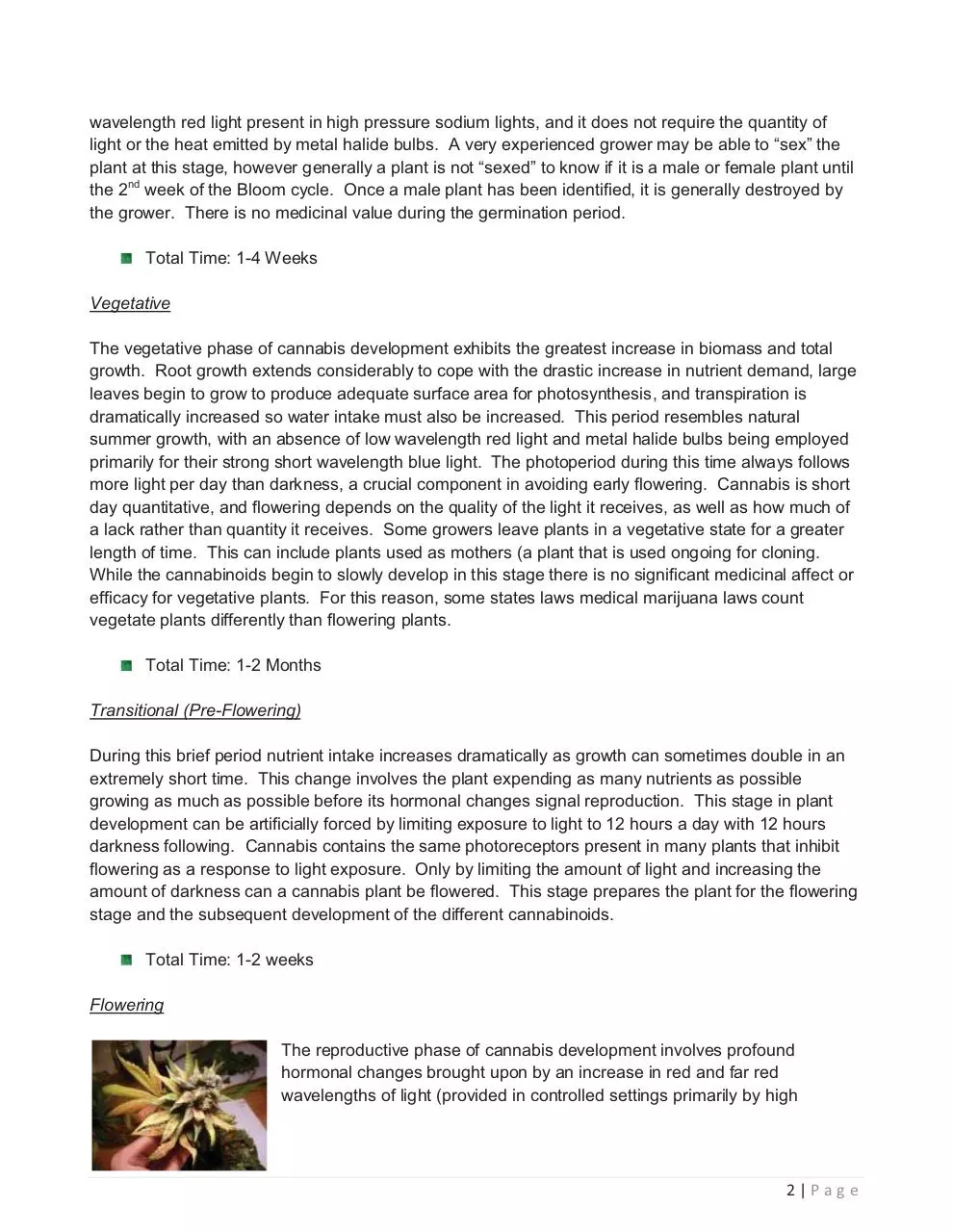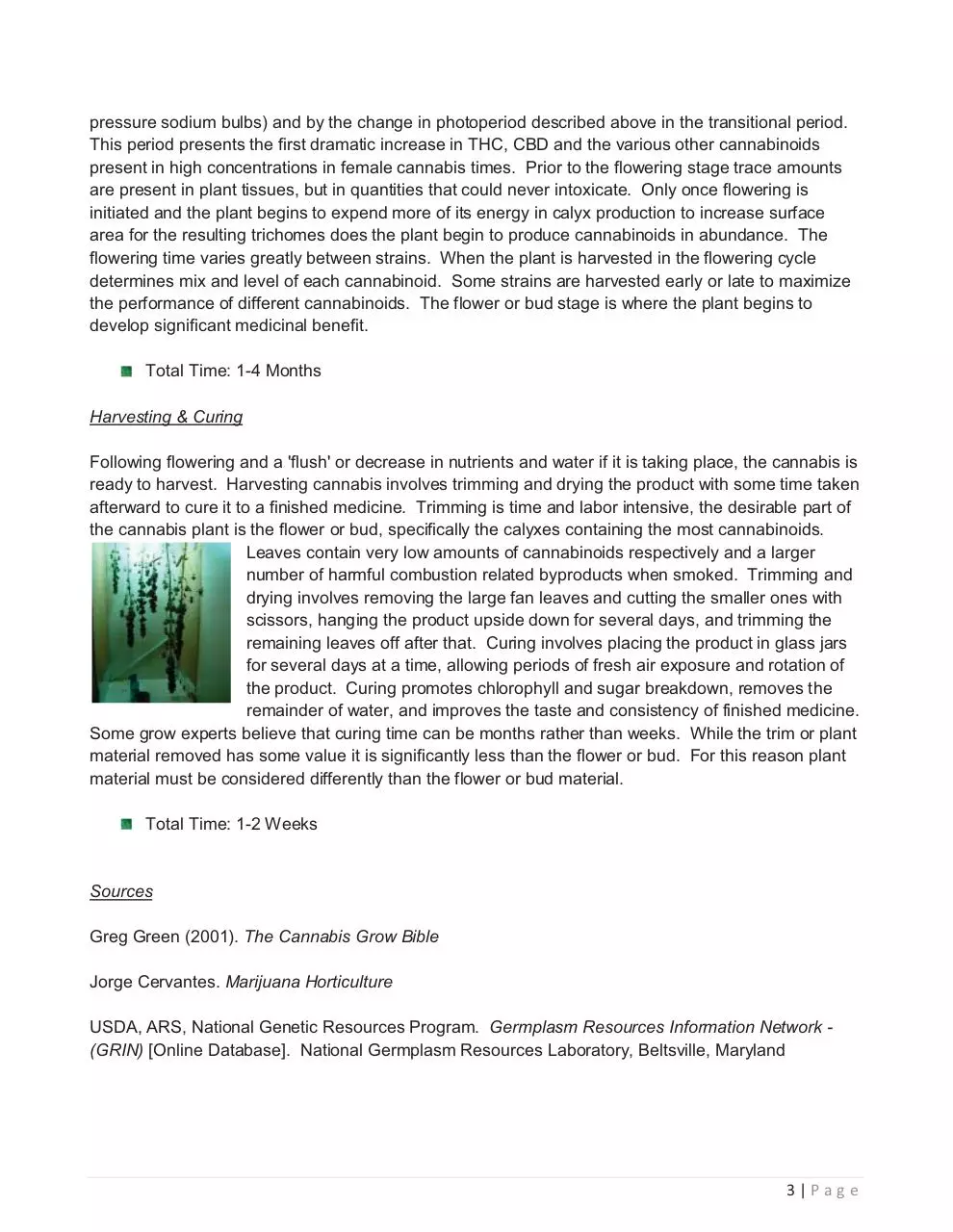Cannabis Life Cycle (PDF)
File information
Title: Cannabis Life CycleA (2).pdf
Author: Danni
This PDF 1.5 document has been generated by Microsoft® Office Word 2007 / Acrobat Distiller 9.3.0 (Windows), and has been sent on pdf-archive.com on 22/11/2017 at 05:07, from IP address 162.72.x.x.
The current document download page has been viewed 431 times.
File size: 65.34 KB (3 pages).
Privacy: public file



File preview
Cannabis Life Cycle
The following provides a glimpse into the Life Cycle of a Cannabis
Plant. This is meant to be a guide and not an absolute as each
strain of Cannabis may require different time sequences.
Individual growers may also have different growing, harvesting
and curing techniques which may significantly alter the time
frames indicated.
Cannabis is an annual dioecious (unisexual) flowering plant. To elaborate, it germinates from a seed,
reaches sexual maturity, reproduces and dies all within one year when growing wild. Its flowers are
unisexual so males and females are distinct plants, but hermaphrodites have been continually
documented.
Modern cultivation techniques can be employed to extend a plant’s natural life cycle, sometimes
almost indefinitely through cloning, allowing favorable phenotypes to exist continually without relying
on the blind luck associated with random genetic shuffling present from natural sexual reproduction.
The time for a branch to form roots is between 5 and 20 days, following which the branch can be
considered an independent plant capable of full growth, with the same genetics as its mother.
The entire cannabis life cycle is described below; clones begin as little more than a branch, until
advantageous roots form at which time the plant most closely resembles a seedling, and eventually
moves into a full vegetative phase.
Germination
Germinating of cannabis seeds requires stratification (absorbing sufficient water) along with darkness
to initiate key metabolic processes that begin sprouting a seedling. Depending on the age of a seed
initial germination may take from a day up to eight; the taproot firmly anchors in the ground and 2
cotyledons emerge within 2-4 days. There is no medicinal value during the germination period.
Total Time: 3-12 Days
Seedling
A cannabis plant is considered a seedling once its cotyledons are exposed and actively beginning
transpiration and photosynthesis. For clarification, cotyledons are the two
small circular leaves that first sprout from a seed; they differ markedly from
the distinctive rigged angular leaves that follow soon after. During this period
a plant exhibits marked phototropism, growing and extending towards
whatever light source offers the appropriate wavelengths. Fluorescent lights
are primarily employed because the plant does not require high quality low
1|Page
wavelength red light present in high pressure sodium lights, and it does not require the quantity of
light or the heat emitted by metal halide bulbs. A very experienced grower may be able to “sex” the
plant at this stage, however generally a plant is not “sexed” to know if it is a male or female plant until
the 2nd week of the Bloom cycle. Once a male plant has been identified, it is generally destroyed by
the grower. There is no medicinal value during the germination period.
Total Time: 1-4 Weeks
Vegetative
The vegetative phase of cannabis development exhibits the greatest increase in biomass and total
growth. Root growth extends considerably to cope with the drastic increase in nutrient demand, large
leaves begin to grow to produce adequate surface area for photosynthesis, and transpiration is
dramatically increased so water intake must also be increased. This period resembles natural
summer growth, with an absence of low wavelength red light and metal halide bulbs being employed
primarily for their strong short wavelength blue light. The photoperiod during this time always follows
more light per day than darkness, a crucial component in avoiding early flowering. Cannabis is short
day quantitative, and flowering depends on the quality of the light it receives, as well as how much of
a lack rather than quantity it receives. Some growers leave plants in a vegetative state for a greater
length of time. This can include plants used as mothers (a plant that is used ongoing for cloning.
While the cannabinoids begin to slowly develop in this stage there is no significant medicinal affect or
efficacy for vegetative plants. For this reason, some states laws medical marijuana laws count
vegetate plants differently than flowering plants.
Total Time: 1-2 Months
Transitional (Pre-Flowering)
During this brief period nutrient intake increases dramatically as growth can sometimes double in an
extremely short time. This change involves the plant expending as many nutrients as possible
growing as much as possible before its hormonal changes signal reproduction. This stage in plant
development can be artificially forced by limiting exposure to light to 12 hours a day with 12 hours
darkness following. Cannabis contains the same photoreceptors present in many plants that inhibit
flowering as a response to light exposure. Only by limiting the amount of light and increasing the
amount of darkness can a cannabis plant be flowered. This stage prepares the plant for the flowering
stage and the subsequent development of the different cannabinoids.
Total Time: 1-2 weeks
Flowering
The reproductive phase of cannabis development involves profound
hormonal changes brought upon by an increase in red and far red
wavelengths of light (provided in controlled settings primarily by high
2|Page
pressure sodium bulbs) and by the change in photoperiod described above in the transitional period.
This period presents the first dramatic increase in THC, CBD and the various other cannabinoids
present in high concentrations in female cannabis times. Prior to the flowering stage trace amounts
are present in plant tissues, but in quantities that could never intoxicate. Only once flowering is
initiated and the plant begins to expend more of its energy in calyx production to increase surface
area for the resulting trichomes does the plant begin to produce cannabinoids in abundance. The
flowering time varies greatly between strains. When the plant is harvested in the flowering cycle
determines mix and level of each cannabinoid. Some strains are harvested early or late to maximize
the performance of different cannabinoids. The flower or bud stage is where the plant begins to
develop significant medicinal benefit.
Total Time: 1-4 Months
Harvesting & Curing
Following flowering and a 'flush' or decrease in nutrients and water if it is taking place, the cannabis is
ready to harvest. Harvesting cannabis involves trimming and drying the product with some time taken
afterward to cure it to a finished medicine. Trimming is time and labor intensive, the desirable part of
the cannabis plant is the flower or bud, specifically the calyxes containing the most cannabinoids.
Leaves contain very low amounts of cannabinoids respectively and a larger
number of harmful combustion related byproducts when smoked. Trimming and
drying involves removing the large fan leaves and cutting the smaller ones with
scissors, hanging the product upside down for several days, and trimming the
remaining leaves off after that. Curing involves placing the product in glass jars
for several days at a time, allowing periods of fresh air exposure and rotation of
the product. Curing promotes chlorophyll and sugar breakdown, removes the
remainder of water, and improves the taste and consistency of finished medicine.
Some grow experts believe that curing time can be months rather than weeks. While the trim or plant
material removed has some value it is significantly less than the flower or bud. For this reason plant
material must be considered differently than the flower or bud material.
Total Time: 1-2 Weeks
Sources
Greg Green (2001). The Cannabis Grow Bible
Jorge Cervantes. Marijuana Horticulture
USDA, ARS, National Genetic Resources Program. Germplasm Resources Information Network (GRIN) [Online Database]. National Germplasm Resources Laboratory, Beltsville, Maryland
3|Page
Download Cannabis Life Cycle
Cannabis Life Cycle.pdf (PDF, 65.34 KB)
Download PDF
Share this file on social networks
Link to this page
Permanent link
Use the permanent link to the download page to share your document on Facebook, Twitter, LinkedIn, or directly with a contact by e-Mail, Messenger, Whatsapp, Line..
Short link
Use the short link to share your document on Twitter or by text message (SMS)
HTML Code
Copy the following HTML code to share your document on a Website or Blog
QR Code to this page

This file has been shared publicly by a user of PDF Archive.
Document ID: 0000699879.